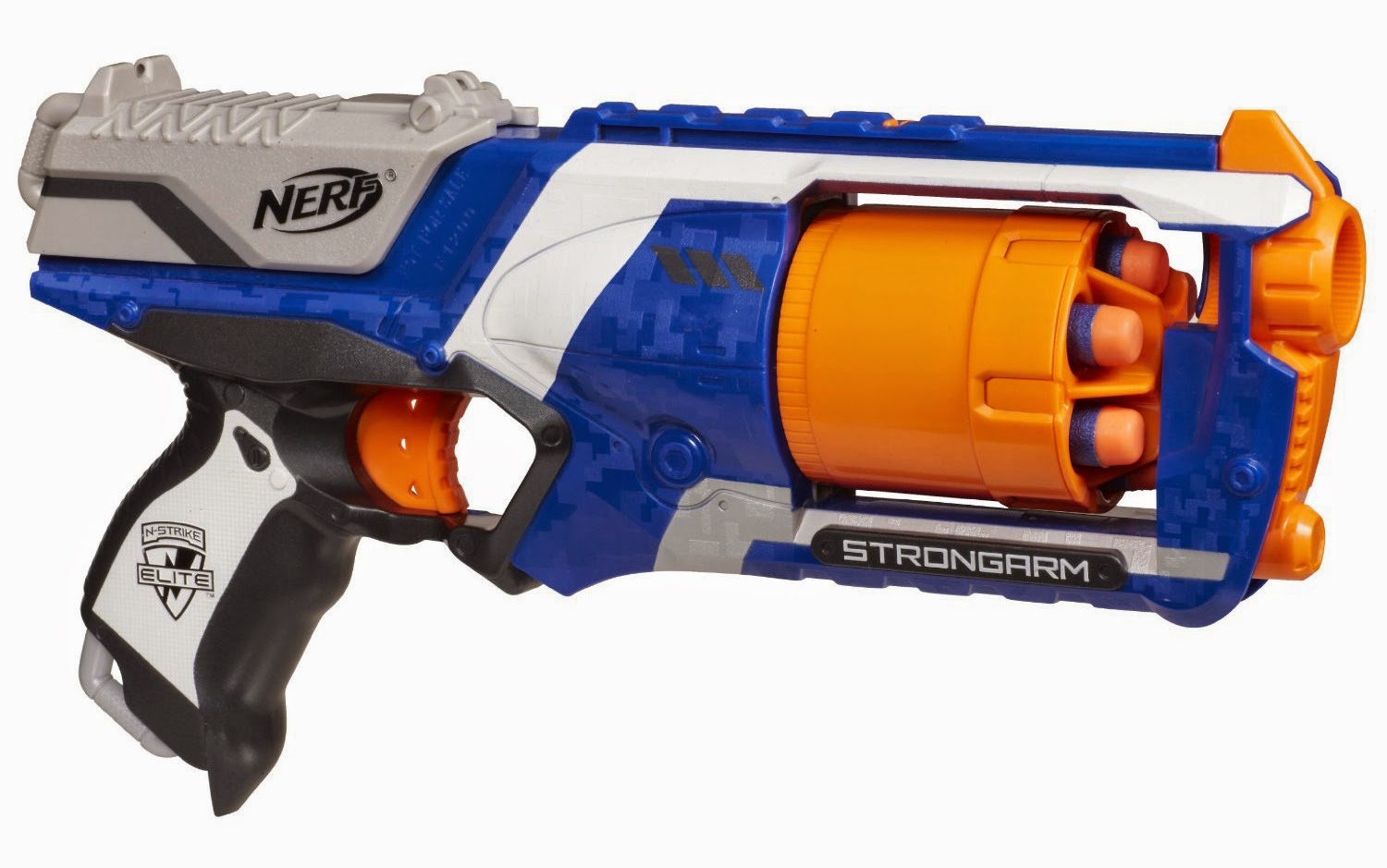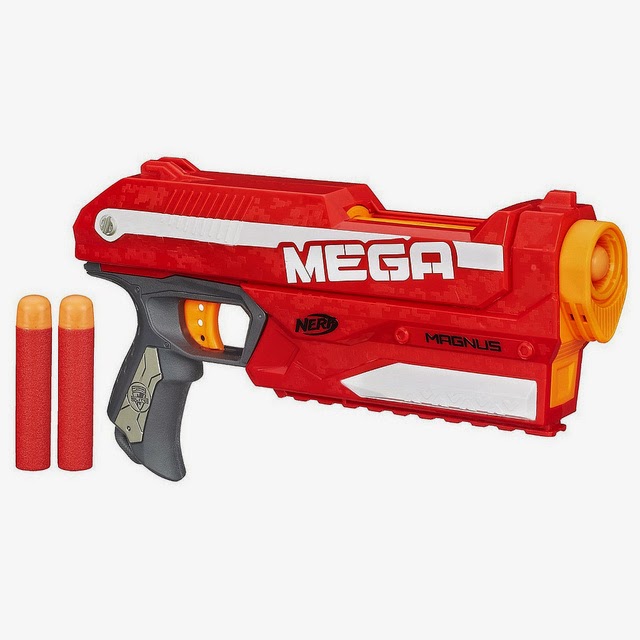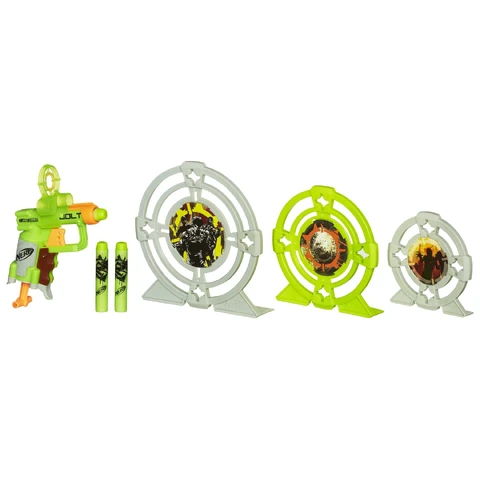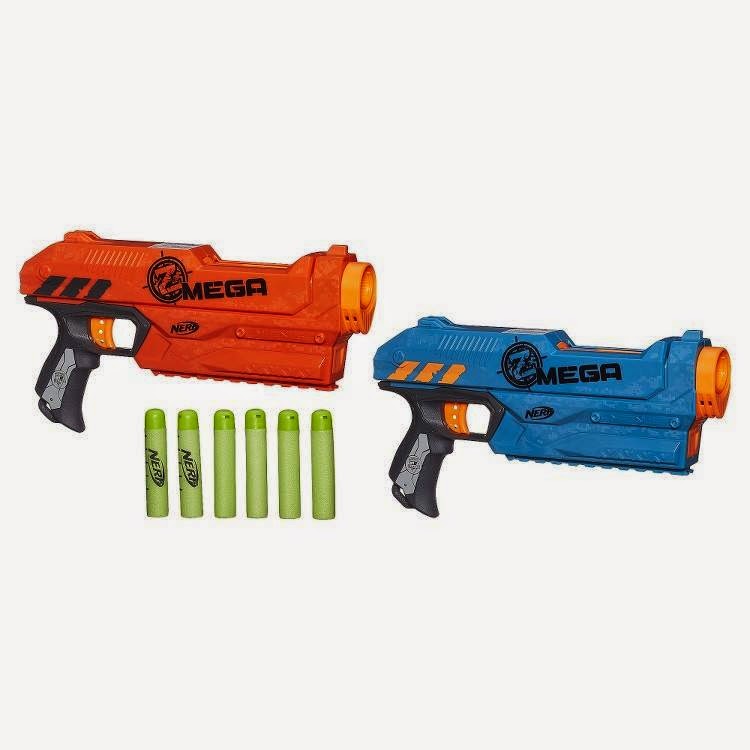Apologies how late this post is, but a holiday will do that if you're unprepared.
As usual, Merry Christmas/Happy Holidays to all of you.Another year, another bunch of Nerf releases, some cool and some less cool. Let's get straight into it.
Format:[Name], [Approx cheap non-sale price in Australia], [orange trigger range claim], [grey trigger range claim] MegaI've started with Mega because it only has a few things in the line.
Mega Magnus, 20AUD, 90ft/27m, 22mThe Magnus came out not long after the disappoint and failure that was the Centurion, it had to be pretty good to redeem the Mega line. Thankfully the Magnus doesn't disappoint, slinging Mega darts a good distance in an awesome handcannon form. The 3 dart inbuilt magazine greatly increases its utility compared to regular single shots, and the huge slide adds to the handcannon feel. For many the Magnus became a favoured blaster, simply because unlike the Centurion it performed as acceptably well and is incredibly fun to use and surprisingly effective if used correctly.
The Magnus also became popular as an underbarrel blaster, akin to the underslung grenade launchers you see in FPS games like CoD and Battlefield.
Mega Thunderbow, 60AUD, 100ft/30m, 24mWhen the first image of the Thunderbow emerged on the internet, it gained much criticism from many people (me included) due to its lack of trigger and unwieldy and bulky design. This was not helped by its incredibly complex internals, featuring gears, gears and more gears. However, many people who bought Thunderbows found that it was actually a lot of fun to use despite its bulk. Having a 5 barrel smart AR system helped significantly, as it meant you could fire off 5 shots in quick succession. The Thunderbow is also an excellent performer, meeting its range claims easily. All in all, while the Thunderbow may not be the most practical blaster, for many it's well liked simply for being a lot of fun, much like the Magnus.
The Centurion also received a Sonic Ice repaint.
Looking ahead to 2015, the Mega line is receiving its Jolt variant, the BigShock, and its Strongarm variant, the much anticipated CycloneShock. Additionally the Mega line is receiving the Berzerker, which is also hotly anticipated. From its beginning with the disappointing Failturion, the Mega line really is just getting better and better.
EliteThe Elite line received only a few new blasters this year, with most Elite releases being recolours.
Elite XD Demolisher 2 in 1, 60AUD, 90ft/27m, 22mThe Demolisher embodies everything we love in assault rifles with underslung grenade launchers from so many FPS games. It comes with a tacticool 10 dart banana clip, a first for Nerf (ignoring that of the Quick 16 since it's clip was not detachable), as well as including its own unique shoulder stock, which holds a spare rocket. Despite being a pump-to-fire blaster, the rocket launcher is actually surprisingly powerful and can compete with or even beat stock grey trigger blasters in range. Sadly the Demolisher begins to fall down when you consider its practicality. Despite its increased range claim it performs just like a regular Elite blaster, akin to the Stryfe. Grey trigger models are even worse, losing out to N-Strike blasters. Additionally, the Demolisher dislikes the aftermarket Koosh dart, as well as the Streamline dart, despite almost all other Elite blasters having no problem with them at all. Additionally, while the stock holds an extra rocket, the stock itself is fairly short, being only a little longer than the Retaliator's stock. The 10 dart banana clip, while tacticool, is larger than a 12 dart straight clip and yet holds less darts, making it impractical.
All in all, while the Demolisher is an extremely tacticool blaster, it fails to live up to its range claims and unless you need the underslung rocket launcher, is also less practical than the much smaller and cheaper Stryfe, or the similarly priced but superior Rapidstrike.
Elite XD Cam ECS, 120AUD (!!!), 85ft, 21mNow the Demolisher was impractical, but at least it had the tacticool 10 dart clip, and rocket launching was surprisingly fun. This thing? Nothing. Despite its range claims it again performs just like a Stryfe. It includes a 12 dart clip which is a favourite of mine, but for $120 I would expect Stampede level accessories, or mind blowing and game breaking performance. But no, what we have here is a Stryfe in a rifle shell, and a terrible camera. The camera is a 0.3megapixel one, and records 640x480 video at 20fps. My iPod Touch was released 4 years ago, yet its camera is much better, being 0.7megapixel, and recording video at 1280x720 at 30fps (though that's not really evident in my videos). The Cam records at quality worse than that of a standard DVD, despite the DVD being almost 20 years old.
In summary, the Cam is a rifle sized Stryfe with a camera apparently from the 1980s, being sold for more than 4x the price of a Stryfe. If the camera was at decent quality and the Cam was half the price, then maybe it would be a decent buy, but as is the Cam is just a huge waste of money,
It includes a 4gb SD card, but that's nearly worthless nowadays too.
Elite XD Rhino Fire, ??AUD (90USD), 90ft/27m, ??mNerf's biggest release this year, the Rhino Fire is seemingly the Elite version of the N-Strike Vulcan, with a tripod, 2 25 dart drums and a "chainsaw grip" handle on top. One of the few modern Nerf blasters with double barrels, the Rhino Fire is unique in that the barrels also pulsate while firing. The overall design seems to mimic old anti air guns, and it certainly does the job of looking cool and being effective for defence. Unlike most Nerf blasters, the Rhino Fire lacks a conventional trigger, instead having a trigger plate on the two handed handle that activates both the flywheels and firing.
Practicality wise the Rhino Fire is unwieldy for regular Nerf war style combat, but is effective for defensive play with its tripod. While it is much cheaper to simply buy two Rapidstrikes and strap them together, the Rhino Fire at least isn't as much of a waste of money as the Cam is.
Along with those releases, a number of blasters have had repaints in keeping with the new white and orange paintschemes. They also get new range claim lies, claiming XD ranges, though there's been no evidence that the XD repaints have any difference to their regular Elite versions.
![]()
![]()
![]()
![]()
![]()
One unusual release is this two pack of Sidestrikes, originally a Zombie Strike blaster with a holster.
Besides the new colour, they're pretty much identical to the ZS Sidestrike.
Looking forward to 2015, the Elite line is receiving a slingshot in the form of the Slingstrike, a pistol carbine in the form of the Sharpfire (that is actually N-Strike, not Elite), and a bullpup clipfed crossbow in the form of the Crossbolt. While they may not be the most practical of blasters, at very least they're all unique.
Zombie StrikeZS received quite a few new releases this year, though not all of them were as interesting or cool as last year's Hammershot and Sledgefire.
ZS Crossfire Bow, 37AUD, --, -- (assumed Elite range claims)The Crossfire Bow is effectively half of a Roughcut, with a single row of 4 smart ARs. Despite the bow arms and strings, the Crossfire is actually just a spring powered blaster, with the pullback rod being connected to the plunger rod. While not a very practical blaster, lacking noteworthy range and having a low capacity and relatively slow rate of fire, the Crossfire Bow is liked by some simply because of the way it looks.
ZS Sidestrike, 19AUD, --, -- (assumed Elite range claims)Internally the Sidestrike is just a slightly altered Firestrike, slide primed instead of pullback rod primed. It performs very similarly, getting acceptable Elite level ranges. Like the Firestrike, it has 2 dart holders below the barrel. However, the Sidestrike's key unique feature is the inclusion of a holster, which can hold either the Sidestrike or Firestrike in either direction, allowing for ambidextrous use. The holster also holds 4 darts. The Sidestrike's handle is particularly comfortable to hold, being smooth and curved compared to many of the sharper Elite handles.
The Sidestrike is Zombie Strike's generic single shot pistol that almost every major line has. It's favoured by some who dislike the other similar single shots, though they're all pretty much the same.
ZS Fusefire, 24AUD, --, -- (assumed Vortex range claims)The Fusefire is quite unique. Not only does it have built in disc holders on the front, but it also has an inbuilt magazine, fed from the back just above the priming sled. It's slightly unusual firing system incorporates a priming sled that you pull back and then release to prime. The internal magazine holds 5 discs. Additionally the Fusefire incorporates glow in the dark disks, charging them with lights in the top section, shown by the transparent green cover. Performance wise the Fusefire performs just like a standard Vortex blaster.
For some the Fusefire has replaced the Vigilon as the Vortex sidearm of choice, as it is easier to reload on the move and in combat, and also holds extra discs in the front. Its futuristic raygun style aesthetic has also attracted some aesthetic modders.
ZS Ricochet, 12AUD, --, --The Ricochet is the Jolt of the Vortex blasters, being the smallest of any Vortex blaster so far. It uses an unusual slide primed pusher system where most Vortex blasters use a torsion spring. Unfortunately, because of flaws in the new firing mech, the Ricochet gets significantly lower ranges than other Vortex blasters. For multiple reasons including the lack of range and the low popularity of Vortex in general, the Ricochet has gotten very little media coverage or use.
ZS Ripshot, 25AUD, --, --The Ripshot uses a similar firing mech to the smaller Ricochet, and has disc holders similar to the Fusefire. Unlike the Fusefire, the Ripshot is just a single shot blaster, and unlike the Ricochet it can achieve respectable Vortex level ranges. Nevertheless, the Ripshot is still just an oversized single shot and so has had little media coverage.
ZS Target Set, ??AUD (10USD), --, --Pretty much every line needs its Jolt repaint, and this is the ZS line's repaint, which includes a clip on sight with dart holders, and a couple of targets. A must get for Jolt collectors, but besides that it's really not anything new.
ZS Slingfire, 39AUD, --, -- (assumed Elite range claims)The Slingfire was one of the most anticipated Fall 2014 releases, because of the cool factor of a lever action rifle. One of the key features advertised was the ability to flip-prime it, which worked suprisingly well with the right technique. Sadly, the Slingfire begins to fall down in practicality, like so many other stylish blasters out there. For whatever ridiculous reason, Nerf has opted to include just a measly 6 dart clip, where other blasters of the Slingfire's price range typically have at very least a 12 dart clip. Additionally, earlier models of the Slingfire seemed to have trouble keeping up with other Elite spec blasters, having a lower than average range. On top of that, while the lever action priming is cool, compared to a pump action such as the EAT or Rampage, it is quite slow and clunky. The clip release is also badly designed, with the release buttons on the side like most springer clipfed blasters, unlike the easier to use rear clip release button like those on flywheel blasters. Especially with the lever action priming mech, it is quite awkward to release a clip from the Slingfire.
Nevertheless, the Slingfire is a favourite blaster of many simply for being a cool and fun lever action blaster, with newer editions seemingly lacking the range issue of older ones.
ZS Doublestrike, 15AUD, --, --Coming off the great success of the Hammershot/Sweet Revenge, the Doublestrike is a miniature two shot hammer action pistol. Unlike the cylinder toting HS/SR, the Doublestrike uses a set of smart ARs to fire two darts consecutively. As a much smaller blaster than the HS/SR, the Doublestrike sadly doesn't get the same ranges. Additionally, due to a design flaw, if not carefully primed, the Doublestrike will pop out the first dart, leaving you with only one dart.
Said design flaw is easily fixed with a little hot glue, but sadly the lack of range is not easily solved due to the limited space in the Doublestrike shell. Nevertheless the Doublestrike is a fun and cool looking pistol, and it does have its fair share of fans.
Along with those new releases, the ZS line has also received some repaints of other blasters for the ZED Squad subline. Besides new colours for the blasters in the line, there are also special printed darts with a syringe type printing, supposedly meant to be a cure for the zombie disease.
The Longshot (35USD) returns in the ZED Squad subline, with a new paintscheme, a 12 dart clip, a new colour scope and lacking the old barrel extension and bipod. Sadly, internally the Longshot is unchanged, meaning it fails to achieve Elite ranges, getting its old N-Strike ranges, and also often jams with Elite darts (depending on unit). Also despite overall losing some value, the Longshot has remained at the same price point as before.
The Magnus (30USD) is also part of the ZED Squad, coming in 2 different paintschemes. One is the same dark turqoise as the Longshot, and a reddish/orangey. If you like the new colours then this ZED Squad 2-pack is for you, otherwise the regular red Mega Magnus works just as well, being half the price for half the blasters.
The Clear Shot (15USD) is a rerelease of the old Dart Tag Stormfire, a single shot pistol. The Clear Shot also comes with a recolour of a special scope, which was previously only available with special edition Super Soaker Shot Blasts in red and blue. Like the other ZED Squad blasters, the Clear Shot is internally unchanged from the old Stormfire, and so achieves sub-Elite ranges. The Clear Shot is mostly desirable purely because of the scope, since the blaster itself is pretty mundane.
Besides the ZED Squad, ZS has a Roughcut 2-pack of two Roughcut repaints. Nothing new from the Elite Roughcuts, so get it if you like the colours. As it's a Costco exclusive, it's also cheaper than getting two individual Roughcuts, provided you have a Costco membership.
Looking forward to 2015, the ZS line is receiving the dual cylinder Flipfury, and will likely be further bolstered by more as-yet-unknown blasters.
RebelleRebelle has taken an entirely new direction from its first wave, with the new subline being called Secrets and Spies. The key feature of the new line is concealing messages on special darts, and reading them using red filters.
Rebelle Agent Bow, 45AUD, 85ft, 20mAn unusual release, the Agent Bow fires arrows instead of darts, and works like a proper bow with its bow string, rather than the fake bows that simply hide plunger tubes. The Agent Bow also has a built in red dot sight, like that of the Pinpoint Sight. As part of the Secrets and Spies line, the Agent Bow's arrow fins can be written on and decoded using the included red filters.
Naturally due to its use of unique ammo (and not getting insane ranges like Zing bows), the Agent Bow is quite impractical for Nerf war use, but if you need to satisfy your inner archer and you must stick with the Nerf brand, the Agent Bow is the most faithful bow that Nerf currently makes.
Rebelle Diamondista, 9AUD, 75ft, 20mUnlike the ZS Crossfire Bow that simply hides a plunger system, the Diamondista is a true crossbow, using a string to propel darts. Because of this, it is almost totally silent when firing, unlike the distinct *thunk* and *pop* or springers, the whine of flywheelers and the *whoosh* of air blasters. While still just a single shot, the Diamondista does have a few fans and users since it's unique among current blasters as a true crossbow.
Rebelle Messenger, 19AUD, 75ft, 20mBack when the Triad and Firestrike were still relatively new, someone had the brilliant idea to hook up the smart AR barrel block of the Triad to the larger plunger of the Firestrike, to produce the awesome hybrid pistol known as the Triadstrike. It combined the 3-shot ability of the Triad with the power potential and body of the Firestrike, making it powerful as well as having multiple consecutive shots. Fast forward a couple of months and Nerf reveals the Rebelle Messenger, effectively making the Triadstrike mod unnecessary. The Messenger packs the power of the Firestrike/Pink Crush, and a barrel system akin to the Triads, making it one of the few single shot sized blasters capable of rapid fire consecutive shots. As a result, it has become quite popular among Nerfers looking for a single shot styled sidearm blaster.
Rebelle Rapid Red, ??AUD (30USD), 75ft, 20mQuite often, Nerf lines would steal blasters from other lines, change them to suit the new line's style. This is particularly applicable to Rebelle, which has stolen many blaster designs from other lines. The Pink Crush for instance is internally almost identical to the Firestrike, ignoring the light. The Sneak Attacker blasters are just Jolts in a new shell, and the Hammershot/Sweet Revenge are internally identical. The Rapid Red is much like these copies, being a Rebelle-d Stryfe. It lacks the stock attachment point and barrel accepting muzzle, and attempts to compensate for the higher price compared to the Stryfe with a unique 12 dart clip that's red with the right side being transparent red. Additionally and uniquely, the clip has an angled bottom.
As the Rapid Red is fundamentally a Stryfe, it has become an alternative to the Stryfe for those who prefer its ergonomics, but its higher price and lack of tacticool options makes it much less popular than the Stryfe.
Rebelle Spylight, 25AUD, 75ft, 20mThe Spylight is a slide primed 6-shot revolver just like the Strongarm. It has a couple of differences, including a small piece in the handle that holds 2 spare darts and the trans red cylinder doesn't pop out. Instead there is sufficient gap around the cylinder holding arm to reload, in the style of the Hammershot/Sweet Revenge. The Spylight also includes a unique attachment, a red light in a flat light blue shell not unlike those that Nerf has previously released in several blasters.
Being effectively a Strongarm, the Spylight does have a few fans but its high price has largely prevented it from becoming a widespread or popular blaster.
Besides the S&S subline, the Rebelle line has also received the Super Stripes subline, which features blasters with zebra style shell paintschemes, different coloured accents and specially printed darts.
Rebelle Five by Five, 25AUD, 75ft, 20mThe 5x5 is just a Super Stripes repaint of the Sweet Revenge. If you read my review of the Sweet Revenge you'll know that I love that thing, and the 5x5 is the same blaster, except without the extras. In the US it costs the same as the Hammershot (where the SR costs 5USD more), so if you wanted to get the Sweet Revenge but didn't care for the extras, here's your best bet for getting it.
Wild Glam Set, ??AUD (20USD), 75ft, 20mAnother repaint, the Wild Glam blaster is just a repainted Pink Crush. What's new is all the extra stuff. The Wild Glam Set comes with a new holster, a new colour set of eye protection glasses and a new colour bandolier. If that sort of stuff appeals to you, then go ahead and get this set. Otherwise the Pink Crush is the exact same blaster for a much lower price.
Rapid Glow, ??AUD (30USD), 75ft, 20mThe Rapid Glow is the only new blaster in the Super Stripes subline, even then being just a retool of the Retaliator. It includes a unique 10 dart Firefly tech clip, with glow-in-the-dark darts. Besides the new shell and the special clip, the Rapid Glow is basically just a Retaliator with less tacticool for a higher price, and so like many of the Rebelle retools, has not garnered a lot of popularity or press.
Looking forward to 2015, Rebelle is receiving quite a few new releases. This includes a blaster that disguises as a purse (the Secret Shot), a tiny folding blaster (the Mini Mischief), and a 4 smart AR barrel block hammer action blaster (the 4Victory), among other things. The Rebelle line seems to be getting the most unusual and unique blasters of the 3 main Elite dart blasting lines, at least to me. With its large variety of new blasters coming out, the Rebelle line seems to have something for everyone.
VortexIt seems that Nerf is getting rid of the Vortex line, as there have been no new Vortex blasters released, announced or leaked aside from the ZS line's 3 Vortex pistols. This is a shame, as the Vortex line had some good stuff going for it, peaking with the Pyragon, still one of the best stock blasters around. Sadly it seems that the Vortex line has been afflicted with the key problem that affects almost all other alternative ammo blaster lines: lack of ammo compatability. The 7.2x1.3cm foam Elite dart is the standard to which blasters must be compatible with, as Nerf is the most dominant of all the blaster franchises.
Dart TagDart Tag is also seemingly dying, though there have been rumours of a return in 2015. 2014 was an incredibly lackluster year for DT, with the release of just a few Jolt reshells. Nevertheless, the velcro Dart Tag dart remains the favourite stock dart of many Nerfers for its balance of range and accuracy.
I think that's all the main blaster releases this year, do comment if you think I missed anything.
Of the 2015 stuff, I'm actually most excited for the "Modulus" whatever it is, because MLD hinted a while back that Nerf would be getting back into the attachments/accessories market in a big way, and Modulus is a perfect name for that. As you would know if you keep up with my posts, I like tacticool, so Modulus sounds like the perfect thing for me provided Nerf can make it practical and effective, while keeping it tacticool.
Blog achievements this year, we ticked over 500,000 views. Half way to the million!
Thanks to all of you who support me, and a special shout-out to some of the guys I've met through Nerf, like
Qi and
Andu, among others.
Where I live (Australia) it's just 2 hours to the new year, so I'll see all you guys next year!


































